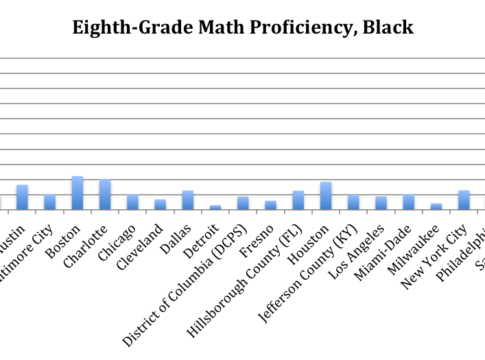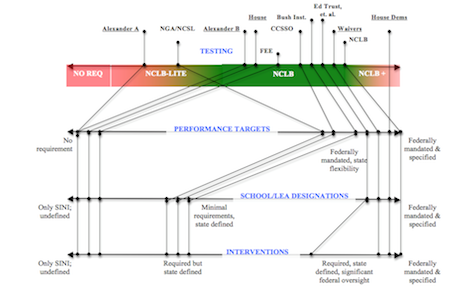As a college freshman in an introductory sociology class, I was assigned the book There Are No Children Here by Alex Kotlowitz. This story of two young boys trying to survive one of Chicago’s most impoverished and dangerous housing projects is absolutely heart-wrenching.
I won’t forget the book’s emotional grip, but equally influential to my intellectual development was the policy and political back story that explained how the boys’ toxic surroundings came to be.
Nearly two decades later, I’m still chastened by the book’s central lesson: A government policy developed by mostly benevolent leaders hoping to improve the lives of the disadvantaged—in this case, by razing old, low-income, ostensibly decaying neighborhoods in favor of gigantic public-housing skyscrapers—did incalculable harm to those it was designed to help.
This has been on my mind in recent weeks, as the national school-closure conversation has flared. Much of that conversation is familiar, but one assertion made by critics, namely that school closures destabilize entire neighborhoods, raises a question that hasn’t been discussed nearly enough. And though some might wave it away as irrelevant or worse, the lessons of the Kotlowitz book force me to take it seriously:
Can a bad school be good for a neighborhood?
Might there be compelling civic or social reasons for keeping open persistently failing or unsafe inner-city schools?
We know there are reasons to close them. First, school turnarounds seldom work (contra the recent statement from AFT president Randi Weingarten), and closures stop us from continuing to send kids to chronically underperforming schools. (The stickiness of failure is even true in the charter sector.)
Second, closures are a part of a continuous-improvement process known as “portfolio management.” Couple closures with new school launches and replications or expansions and you can move the quality curve to the right. This is the heart of my book, The Urban School System of the Future.
(There was a sophisticated discussion of this matter at the recent Bellwether book event. Kaya Henderson, John White, and Mike Casserly did a nice job of explaining the various forces involved. Emma Brown from the Post captured some the back and forth here.)
Third, as explained by Checker Finn, financial considerations make some closures unavoidable—and the likeliest targets are the district’s lowest performers, both because they’re not serving kids well and because they’ve typically seen their enrollments reduced by, among other things, students leaving in search of better educational options.
The anti-closure camp generally counters with a trio of time-worn and ultimately unpersuasive assertions.
• Their “fix-it-don’t-close-it” case is overwhelmed by empirical evidence.
• Their “closures-are-an-anti-union-strategy” argument can’t explain why reformers are also willing to close non-unionized, low-performing charter schools.
• Their “closures-are-a–civil-rights-violation” argument causes most to reply, “It’s a far greater violation to force low-income African American and Latino children to remain in failing, unsafe schools.”
Hence the camp that favors judicious but firm use of school closures increasingly carries the day.
Yet another argument has been waiting to be made, however—one that stokes the communitarian tendencies of my brand of conservatism. It starts with awareness that good schools are a powerful asset for troubled neighborhoods. Indeed, I’ve argued in many places that the closure of excellent inner-city Catholic schools is terrible for such communities. I’ve made the case that high-performing, high-poverty schools can provide safety, stability, and hope to at-risk kids and their families and that these features have immeasurable value in distressed neighborhoods beset by myriad challenges.
But perhaps my view has been too narrow; maybe I’ve put too much weight on the “high-performing” part. Maybe all urban public schools—perhaps even all schools—deserve a greater degree of deference because of characteristics associated with their “local-ness.”
For example, the school could be the major employer of adults in the area.
Even if educationally dysfunctional, the school likely has its share of caring, educated adults who serve as role models and mentors for needy children.
The school may serve as the community hub for social services or civic activities.
Maybe its athletic teams still serve as a source of community pride.
It could be the neighborhood’s last connection to a happier past. Perhaps this school was once the gem of the school system. It might have been the city’s first desegregated school. Maybe, pre-Brown, though segregated, it succeeded academically in breathtaking fashion. Perhaps it’s named after a revered civil-rights leader.
It might have been among the first employers to practice nondiscrimination, paving a pathway to the middle class for countless minority families.
Maybe the neighborhood sees that school as the last thing that is actually theirs. Other families moved away. Businesses shut down. Churches closed their doors. But their school remains.
It might be the case, then, that in these and other ways, the school—notwithstanding its persistent low academic achievement—acts as an important strand in the invisible web of social connectivity that helps to hold a community together despite all the malign forces trying to pull it apart.
Those who cleared Chicago’s “slums” to make way for new high-rise public-housing towers didn’t realize that they were severing intricate, generations-old social bonds. This loss of connection, when combined with the ills of concentrated poverty and the inherent flaws of the new building complexes, turned these behemoths into modern-day Trojan Horses: marvelous to behold from the outside (at least when they were new) but with danger lurking inside.
Environmental parallels are numerous: misbegotten projects that cleared eyesore swamps and walls of mangroves to make way for highways, waterfront condos, and more. We found out too late that these “messy” wetlands actually served as massive water filters, flood preventers, wildlife protectors, fish incubators, and much more. Profound environmental degradation was the consequence of well-intentioned, if naïve, attempts at progress.
To be sure, there are enormous differences between these examples and thoughtful, surgical school-closure strategies. Unlike quiet wetlands, failing, dangerous schools do real harm and, if their students move into higher-performing and safer schools, their replacements bear no resemblance to Cabrini-Green.
My point is merely that those pursuing school-closure strategies should be mindful that every school, even the lowest-performing, is woven into the fabric of its neighborhood—and tugging on that thread affects the entire cloth.
That doesn’t mean the scale tips to the “no closures” side. I remain a committed proponent of smart school-replacement strategies and portfolio management.
But it does mean that reformers should acknowledge both sides of the scale and recognize that, when the case for closure prevails, the arguments on the other side haven’t been eliminated; they’ve just been outweighed in a particular case.
That approach, I believe, is the responsible way to go about policymaking generally. And in this case, its effect on policy implementation in cities across the nation would matter: we’d see greater prudence in the process of deliberation, improved communication to stakeholders, and more thoughtful and respectful execution of an undesirable but ultimately necessary decision.
—Andy Smarick
This blog entry first appeared on the Fordham Institute’s Flypaper blog





